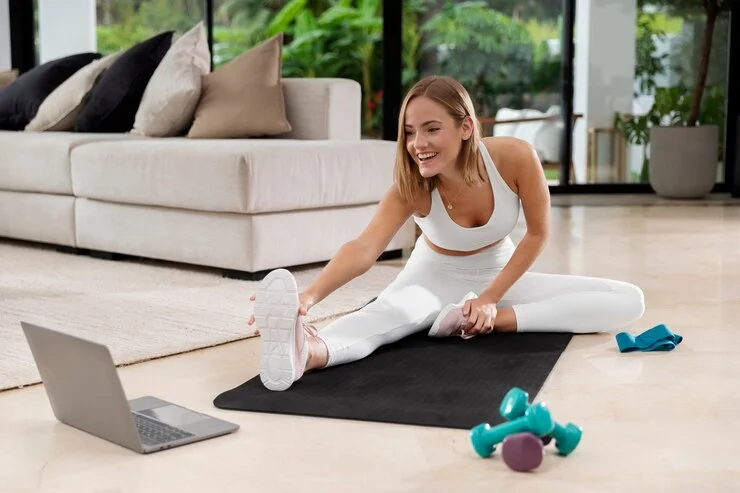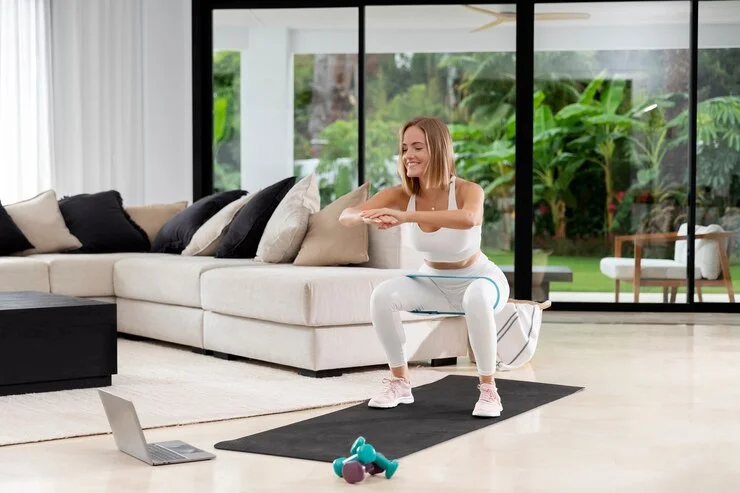How to choose a yoga mat in 2024
Introduction
In the world of yoga, your mat serves as more than just a piece of equipment. It is your sacred space for growth, reflection, and transformation. As we enter the year 2024, the variety and quality of yoga mats available have evolved significantly, and deciding to choose the right one is both exciting and overwhelming. Whether you are an experienced yogi or a beginner, a proper mat can enhance your practice by providing essential support, grip, and comfort. This blog is intended to help you navigate through the maze of options, focusing on materials, thickness, eco-friendliness, and other crucial factors so you can find a mat that aligns with your practice, values, and lifestyle.
Understanding Yoga Mat Materials

The texture, stickiness, eco-friendliness, and durability of your yoga mat are influenced by its material. Let’s take a closer look at some commonly used materials:
- PVC: Durable and offers great grip, but not the most eco-friendly option.
- TPE (Thermoplastic Elastomer): A more eco-friendly alternative to PVC, TPE mats are recyclable and offer a good balance of softness and support.
- Natural Rubber: Offers excellent grip and durability. Most natural rubber mats are eco-friendly, though individuals with latex allergies should be cautious.
- Cork: Naturally antimicrobial and eco-friendly, cork mats provide a unique non-slip surface that improves with moisture.
- Jute: Another eco-friendly option, jute mats offer a unique texture and good grip, though they may be less durable than other materials.
When choosing a material, consider your environmental values, the type of yoga you practice, and any allergies or sensitivities.
Deciding on Thickness
The thickness of your yoga mat significantly affects your practice, offering a spectrum from thin travel mats to plush options that cushion joints. Here’s how to navigate this choice:
- Thin Mats (1/16 to 1/8 inch): These mats are lightweight and offer a strong connection to the floor, enhancing stability in standing poses. They’re ideal for more dynamic styles of yoga or for yogis who prefer to feel a firm grounding. However, they may not provide enough cushioning for knees, hips, and backs during seated or kneeling poses. Thin mats are also travel-friendly, easily fitting into suitcases or yoga mat carriers.
- Standard Thickness (1/8 to 1/4 inch): A standard thickness mat is a versatile option, striking a balance between cushioning and connectivity. It’s suitable for a variety of yoga styles, from Vinyasa to Hatha, offering enough support for most practitioners without compromising stability.
- Thick Mats (1/4 inch and above): Thick yoga mats are ideal for restorative practices, Yin yoga, or anyone seeking extra joint protection. These mats provide ample cushioning, which can be particularly beneficial for practitioners with injuries or sensitivity. The trade-off is a potential decrease in stability for balance poses, where a too-soft surface might lead to wobbling.
When considering thickness, reflect on your yoga practice, personal comfort preferences, and any physical needs. Thick versus thin yoga mats: Which is better? ultimately depends on your individual requirements and the type of yoga you enjoy.

Non-Slip Mats for Safety and Performance
A non-slip yoga mat is essential for safety and performance, especially in styles like Hot Yoga, where sweat can make surfaces slippery. The best non-slip yoga mats for 2024 combine innovative materials with textured surfaces to ensure grip even in the sweatiest conditions.
- Material Matters: PVC and natural rubber are known for their excellent grip. Some eco-friendly TPE mats also offer impressive non-slip properties. Look for mats with a textured surface or patterns designed to increase traction.
- Hot Yoga Favorites: For Hot Yoga enthusiasts, a mat with a moisture-absorbing top layer, such as cork or a microfiber blend, can provide extra grip as it gets wet. These mats often come with a rubber base for stability.
- Grip Enhancements: Some mats are designed with additional grip enhancements, such as raised patterns or extra-coarse textures. These features can be particularly helpful for dynamic practices where you move frequently between poses.
Choosing a non-slip mat not only supports your physical alignment and posture but also enhances your confidence to engage in your practice fully. Non-slip yoga mat options for hot yoga have evolved, with brands now offering solutions that cater specifically to the challenges of high-intensity and sweat-inducing sessions.
Eco-Friendly Yoga Mats for the Conscious Yogi

In 2024, eco-friendliness is not just a trend; it’s a necessity. Eco-friendly yoga mats cater to the environmentally conscious yogi, combining sustainability with performance. Here’s how to make a green choice:
- Sustainable Materials: For an eco-friendly option, choose mats made from natural rubber, jute, cork, or organic cotton. These materials are renewable and biodegradable, and natural rubber and cork are non-slip.
- Non-Toxic Production: Beyond the material, consider how the mat is made. Eco-friendly yoga mats should be free from toxic chemicals like phthalates, which are often found in PVC mats. Many brands are transparent about their production processes, emphasizing their commitment to non-toxic practices.
- Durability and Recyclability: An eco-friendly mat should not only be made from sustainable materials but also stand the test of time. Durability means less waste, and recyclability ensures the mat can be processed responsibly at the end of its life.
For beginners, best eco-friendly yoga mats for beginners offer a balance between eco-consciousness, affordability, and performance, making them an excellent choice for those new to yoga. Investing in an eco-friendly mat is a step towards a more sustainable practice, aligning your yoga journey with environmental stewardship.
Travel-Friendly Yoga Mats for Yogis on the Go

For yogis who frequently travel, finding a mat that combines portability with performance is key. Travel-friendly yoga mats are lightweight, foldable, and easy to pack, ensuring you can maintain your practice anywhere.
- Lightweight and Compact: The best travel yoga mats weigh less and are thinner than standard mats, making them easy to roll or fold into your luggage. Look for mats around 1/16 inch thick that do not compromise on durability or grip.
- Material Flexibility: While maintaining a thin profile, these mats should also be made of flexible materials that can withstand being folded without losing their shape or functionality.
- Dual-Purpose Mats: Some travel mats are designed to be used on top of rental mats or hotel carpets, providing a clean, personal surface that offers additional grip and hygiene.
Selecting a travel yoga mat means prioritizing ease of transport and convenience, with options available that cater to the nomadic yogi without sacrificing the quality of their practice.
Care and Maintenance of Your Yoga Mat

Proper care and maintenance extend the life of your yoga mat, keeping it clean, hygienic, and performing at its best. Here’s how to keep your mat in top condition:
- Regular Cleaning: Wipe your mat down after each practice with a soft cloth and a gentle, natural cleaner. Avoid harsh chemicals that can degrade the mat material.
- Deep Cleaning: For more thorough cleaning, use a mixture of mild detergent and water to scrub the surface with a soft brush gently. Rinse the surface thoroughly and allow it to air dry.
- Storage: Store your mat in a cool, dry place, avoiding direct sunlight, which can cause certain materials to degrade. Roll it loosely to avoid creases or damage.
- Avoiding Common Mistakes: Don’t soak your mat in water or put it in the washing machine unless the manufacturer specifically states it’s machine-washable. These practices can damage the mat’s material and structure.
How to clean and maintain your yoga mat effectively means adopting a routine that protects its materials and ensures it remains a hygienic and supportive space for your practice.
Making the Right Choice: Brand and Price Comparison
In 2024, the yoga mat market is more diverse than ever, with options to suit every preference and budget. Understanding how to navigate brand and price comparisons can help you find a mat that offers the best value for money.
- Top Brands: Several leading brands are known for their quality, innovation, and commitment to sustainability. Brands like Manduka, Liforme, and JadeYoga consistently receive high marks for their durable, high-performance mats. These brands often offer mats in various materials, thicknesses, and textures to cater to different yoga practices and preferences.
- Price Range: Yoga mats can range from affordable options under $20 to premium models priced over $100. Generally, the cost reflects the mat’s material, durability, and special features, such as eco-friendliness or unique design elements. While it’s tempting to opt for cheaper mats, investing in a higher-quality mat can be more cost-effective in the long run due to its longevity and performance.
- Comparing Features: When comparing mats, look beyond the price. Consider the mat’s weight, portability, grip, and cushioning. For eco-conscious yogis, the environmental impact of the mat’s production and materials is also a crucial factor. Reading yoga mat reviews can provide insights into how mats perform in real-world conditions, highlighting strengths and potential drawbacks.
- Finding the Best Deals: To find the best deals on yoga mats, keep an eye on sales, especially around holidays or during off-season periods. Many brands also offer discounts for first-time buyers or through subscription services. Comparing prices across different retailers, both online and in physical stores, can also help you find competitive pricing.
FAQ’s
- What is the best thickness for a yoga mat in 2024?
- The ideal thickness depends on your practice and comfort needs. A standard thickness of 1/8 to 1/4 inch suits most yogis, offering a balance between cushioning and stability. For those seeking more comfort or with joint concerns, a thicker mat (over 1/4 inch) might be preferable.
- Are eco-friendly yoga mats worth the investment?
- Yes, eco-friendly yoga mats, made from sustainable materials like natural rubber or cork, are worth the investment for environmentally conscious practitioners. They often match the durability and performance of traditional mats while minimizing environmental impact.
- How do I clean my yoga mat without damaging it?
- Clean your yoga mat with a soft cloth and a gentle, natural cleaner. Avoid harsh chemicals and excessive water. For deep cleaning, use a solution of water and mild detergent, rinse thoroughly, and air dry. Always follow the manufacturer’s care instructions.
- Can a non-slip yoga mat improve my practice?
- Absolutely. A non-slip yoga mat provides the stability and grip needed for safety and confidence in poses, especially in dynamic styles or hot yoga. It helps prevent slipping, allowing for better alignment and focus.
- How often should I replace my yoga mat?
- The lifespan of a yoga mat depends on its material, frequency of use, and care. On average, a yoga mat can last between 6 months to a year with regular use. Signs that it’s time for a replacement include noticeable wear, reduced grip, and tears.
Conclusion
Choosing the right yoga mat is a personal journey that reflects your practice, values, and lifestyle. In 2024, with advancements in materials, design, and sustainability, yogis have an unprecedented array of options. By considering factors like material, thickness, eco-friendliness, grip, and portability, you can select a mat that enhances your yoga practice, supports your body, and aligns with your ethical beliefs. Remember, the best yoga mat is one that feels like a natural extension of your practice, offering comfort, stability, and joy as you explore the depths of yoga.







